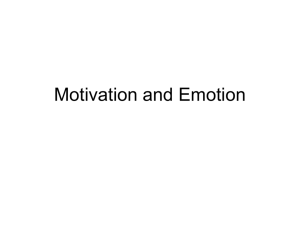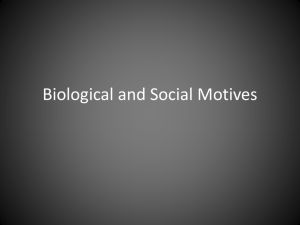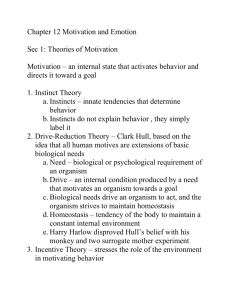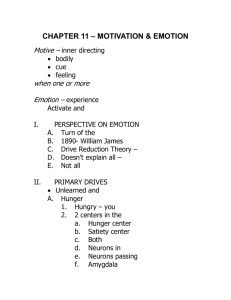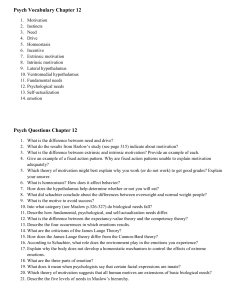LEARNING OBJECTIVES To demonstrate mastery of this chapter
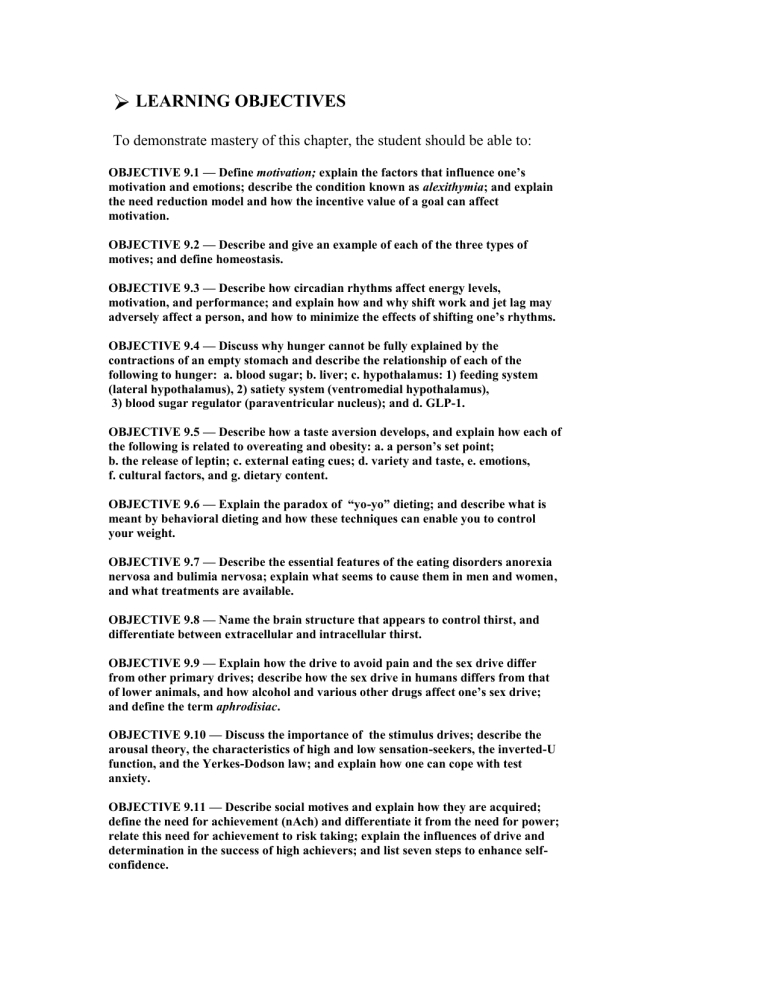
LEARNING OBJECTIVES
To demonstrate mastery of this chapter, the student should be able to:
OBJECTIVE 9.1 — Define motivation; explain the factors that influence one’s motivation and emotions; describe the condition known as alexithymia; and explain the need reduction model and how the incentive value of a goal can affect motivation.
OBJECTIVE 9.2 — Describe and give an example of each of the three types of motives; and define homeostasis.
OBJECTIVE 9.3 — Describe how circadian rhythms affect energy levels, motivation, and performance; and explain how and why shift work and jet lag may adversely affect a person, and how to minimize the effects of shifting one’s rhythms.
OBJECTIVE 9.4 — Discuss why hunger cannot be fully explained by the contractions of an empty stomach and describe the relationship of each of the following to hunger: a. blood sugar; b. liver; c. hypothalamus: 1) feeding system
(lateral hypothalamus), 2) satiety system (ventromedial hypothalamus),
3) blood sugar regulator (paraventricular nucleus); and d. GLP-1.
OBJECTIVE 9.5 — Describe how a taste aversion develops, and explain how each of the following is related to overeating and obesity: a. a person’s set point; b. the release of leptin; c. external eating cues; d. variety and taste, e. emotions, f. cultural factors, and g. dietary content.
OBJECTIVE 9.6 — Explain the paradox of “yo-yo” dieting; and describe what is meant by behavioral dieting and how these techniques can enable you to control your weight.
OBJECTIVE 9.7 — Describe the essential features of the eating disorders anorexia nervosa and bulimia nervosa; explain what seems to cause them in men and women, and what treatments are available.
OBJECTIVE 9.8 — Name the brain structure that appears to control thirst, and differentiate between extracellular and intracellular thirst.
OBJECTIVE 9.9 — Explain how the drive to avoid pain and the sex drive differ from other primary drives; describe how the sex drive in humans differs from that of lower animals, and how alcohol and various other drugs affect one’s sex drive; and define the term aphrodisiac.
OBJECTIVE 9.10 — Discuss the importance of the stimulus drives; describe the arousal theory, the characteristics of high and low sensation-seekers, the inverted-U function, and the Yerkes-Dodson law; and explain how one can cope with test anxiety.
OBJECTIVE 9.11 — Describe social motives and explain how they are acquired; define the need for achievement (nAch) and differentiate it from the need for power; relate this need for achievement to risk taking; explain the influences of drive and determination in the success of high achievers; and list seven steps to enhance selfconfidence.
OBJECTIVE 9.12 — List (in order) the needs found in Maslow’s hierarchy of motives; distinguish between basic needs and growth needs; explain why Maslow’s lower (physiological) needs are considered prepotent; and define and give examples of meta-needs.
OBJECTIVE 9.13 — Distinguish between intrinsic and extrinsic motivation, and explain how each type of motivation may affect a person’s interest in work, leisure activities, and creativity.
OBJECTIVE 9.14 — Define emotion and mood, and explain how emotions aid survival; describe the three elements of emotions; list Plutchiks’ eight primary emotions and how they combine to make more complex emotions; and explain how a person can experience two opposite emotions simultaneously.
OBJECTIVE 9.15 — Describe the role of the sympathetic and parasympathetic branches of the ANS in emotional arousal; explain how the parasympathetic rebound may be involved in cases of sudden death; discuss the use and limitations of the lie detector (polygraph); and describe the proposed airport security techniques for detecting lies.
OBJECTIVE 9.16 — Discuss Darwin’s view of human emotion and which facial expressions appear to be universal and most recognizeable; describe cultural and gender differences in emotional expression; and discuss kinesics, including the emotional messages conveyed by facial expressions and body language.
OBJECTIVE 9.17 —Describe and give examples of the following theories of emotion: a. James-Lange theory; b. Cannon-Bard theory; c. Schachter’s cognitive theory; d. the effects of attribution on emotion; e. the facial feedback hypothesis, including the dangers of suppressing emotions; f. emotional appraisal; and g. the contemporary model of emotion.
OBJECTIVE 9.18 — Describe the concept of emotional intelligence and its five skills, and discuss the benefits of positive emotions.




